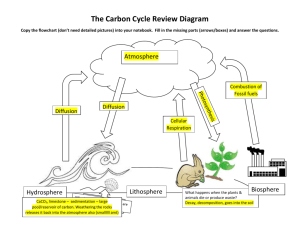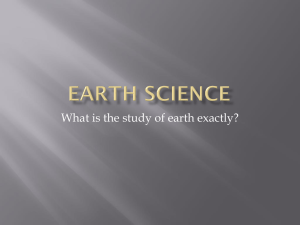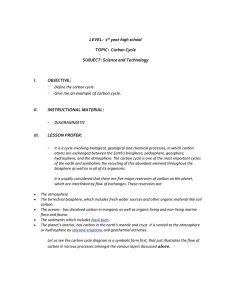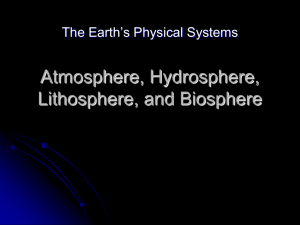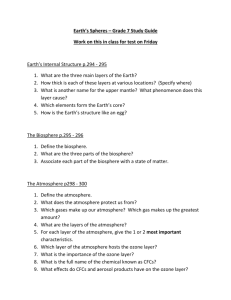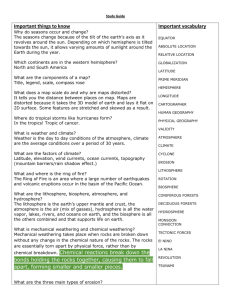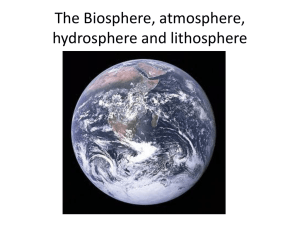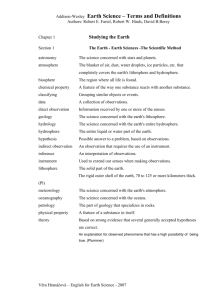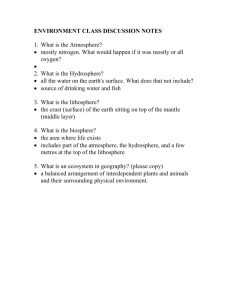Carbon Cycle
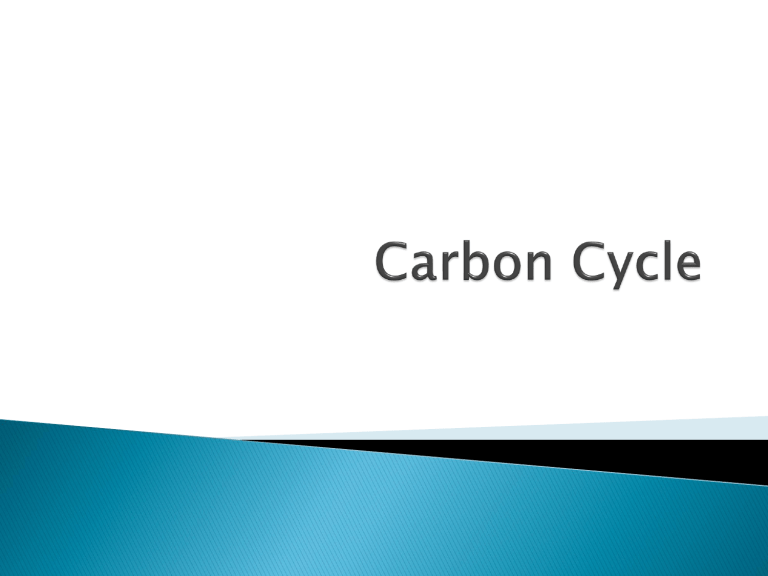
Explain how chemical and physical processes cause carbon to cycle through the major earth reservoirs.
All living organisms are built of carbon compounds. It is the fundamental building block of life.
Carbon is cycled among Earth's reservoirs, just like water.
Carbon can form four bonds at a time.
It bonds with hydrogen, oxygen, nitrogen, and other elements. It can also bond to other carbon atoms, forming a long chain of atoms
These unique properties of carbon allow it to function as the building block for living things.
Biosphere – living things
Atmosphere – the air
Hydrosphere – the water
Lithosphere/ Geosphere – the ground
Carbon is found in each of these
!
The reservoir known as the biosphere is comprised of living things – plants, animals and everything else in between!
http://www.biologyonline.org/dictionary/Biosphere flmnh.ufl.edu
wildarunachal.org
The biosphere is all life on our planet.
This includes living organisms as well as the un-decomposed remains of dead organisms.
The biosphere includes life on land and in the oceans
Living things on our planet are carbon-based because most of the molecules in them are chains of carbon atoms linked together.
In the biosphere, carbon is contained within organic molecules which contain carbon, oxygen, hydrogen, and nitrogen.
Lecithin – triglyceride
http://www.theresilientearth.com/?q=content/biodiversitybalderdash
The reservoir known as the atmosphere is comprised of the whole mass of air surrounding the Earth kidsgeo.com
http://www.merriam-webster.com/dictionary/atmosphere vtaide.com
In this reservoir, carbon is found as carbon dioxide (CO
2
)
Carbon dioxide comprises less than 5 % of the atmosphere. It has a residence time of 10 years.
But, it plays an important role with regards to our planet’s temperature, as we will discuss later on.
This reservoir encompasses all of the waters on the earth's surface, such as lakes and oceans.
The hydrosphere covers about 70% of the surface of the Earth and is the home for many plants and animals.
kidsgeo.com
natasha-hydrosphere.blogspot.com
In the hydrosphere, carbon mainly exists as dissolved CO
2
Marine life including plankton and shellfish use this dissolved CO skeletons.
2 combined with Ca as calcium carbonate to form their shells and
This reservoir consists of the outer solid part of the earth, including the crust and uppermost mantle.
oceansjsu.com
http://earthquake.usgs.gov/learn/glossary/?
term=lithosphere exploratorium.edu
The lithosphere consists of sediment and rocks of the upper crust of the Earth.
Carbon enters the lithosphere through ocean sediments and by the burial of decaying organic matter.
Carbon can be found in the lithosphere in two forms
Limestone / Dolomite - carbon in this rock originates from the living things in the ocean.
Upon their death, these organisms become part of ocean sediments and over time they convert to limestone and becomes part of the lithosphere carbon reservoir.
Coal, oil, and natural gas - these are the remains of ancient plants and plankton which have undergone geologic processes.
http://eri.gg.uwyo.edu
Basic Pathways for
Movement of Carbon
Diffusion – movement of substances from an area of high concentration to an area of low concentration
Respiration – the process by which cells gain energy from organic molecules which consumes oxygen and releases carbon dioxide
Photosynthesis – the process by which plants create glucose by combining carbon dioxide and water and utilizing the sun’s energy
Basic Pathways for
Movement of Carbon
Eruption of Gases / Volcanic Eruptions – release of gases from the earth’s crust
Burial and Sedimentation – the process by which loose materials deposited on the
Earth’s surface form layers and eventually form rock
Weathering and Erosion – the chemical and physical processes of breaking apart rocks into smaller pieces
Photosynthesis
Respiration
Decomposition
Diffusion beta.lpb.org
• Minutes to Years
Weathering and erosion
Accumulation of carbon-rich plant and animal material in sediments
Fossil fuel formation
This takes millions of years beta.lpb.org
climate.be
You will learn more about these from your reading assignment tonight.
Sinks are ways that carbon is stored for long periods without being reintroduced to the atmosphere
Sources are ways that carbon is moved into the atmosphere
When in balance, the total carbon dioxide emissions and removals from the entire carbon cycle are roughly equal.
Currently, the sources are overpowering the sinks
Billions of tons of atmospheric CO
2 are removed from the atmosphere by oceans and growing plants, which function as ‘sinks,’
This carbon is emitted back into the atmosphere annually through natural processes also known as ‘sources.’
Animals and plants undergo respiration
◦ This moves C from biosphere to atmosphere
The oceans undergo diffusion of CO
2
◦ This moves C from hydrosphere to atmosphere
Volcanoes undergo eruptions which release gases
◦ This moves C from lithosphere to atmosphere.
Rocks and minerals undergo weathering and erosion
◦ This moves C from lithosphere to atmosphere or hydrosphere.
Plants undergo photosynthesis ;
◦ This moves CO
2 from the atmosphere to the biosphere.
Oceans take in CO hydrosphere.
2 by diffusion
◦ This moves carbon from the atmosphere to the
Fossil fuels form over millions of years from buried plant and animal material
When fossil fuels are burned to produce energy their carbon is released into the atmosphere as
CO
2
.
This is the largest source of CO
2 globally emissions kids.britannica.com
geothermal.marin.org
thedailygreen.com
Trees cut down and burned
Impacts temp. and stability of the soil
◦ Soil erosion
◦ Inc. in temp. because soil no longer covered by vegetation
How does it affect the C cycle?
en.wikipedia.org
plu.edu
time.com
Calcium carbonate is heated to produce lime and CO
2
US: 7 – 10 billion metric tons of C per year
How does it affect the C cycle?
stateoftheusa.org
pmhl.co.uk
Cattle burps and flatulence
Respiration
How does it affect the
C cycle?
environmentalparliament.org
oklahomafarmreport.com
Flooding of rice paddies causes underwater organic matter to decompose
Methane (CH
4
) is released
How does it affect the C cycle?
Rice Farming in Louisiana
Rice Farming in Spain agrariancrisis.in
geobloggingwithmark.blogspot.com
geographyfieldwork.com
Growing trees and plants remove CO
2 from the atmosphere and store it in the biosphere.
Humans cause deforestation, which erases this key carbon sink.
Carbon sequestration
Capturing C from power plants and pumping it underground
Expensive
How does it affect the C cycle?
carboncapture.us
How does it affect the C cycle?
treehugger.com
masterfile.com
jiyolive.com
http://www.uwsp.edu/geo/faculty/ritter/geog101/textbook/earth_s ystem/biogeochemical_cycles.html
http://www.actewagl.com/education/Glossary/default.aspx?letterSe
arch=C http://www.eoearth.org/article/Carbon_cycle http://www.infoplease.com/ce6/sci/A0857177.html
http://www.oznet.ksu.edu/ctec/Carbon/carboncycle.htm
http://www.waterencyclopedia.com/Bi-Ca/Carbon-Dioxide-in-the-
Ocean-and-Atmosphere.html
http://eri.gg.uwyo.edu/resources/Energy/coal/information/formatio n/carbonCycle/humanEffect.asp
http://www.epa.gov/climatechange/emissions/co2_human.html
